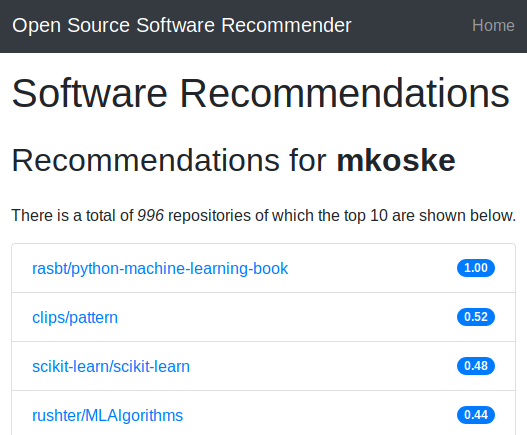A coursework for TIETS43 Recommender Systems at University Of Tampere.
The purpose of this coursework is to implement recommender system which recommends open source software repositories for user based on his Github metadata.
Github metadata currently include:
Repository languages and topics from
- users' own repositories
- starred repositories
- followed repositories
Data also includes both the README and LICENSE -files in base64-encoded format.
- Anaconda or Minicoda (or whatever Python distribution you like, but these are easiest, though)
- Git (if you want to clone the repository, otherwise you can just download the repository as ZIP-archive)
- Create new environment by running
conda env create --name recommender --file requirements.txtin the repository root directory. - Run
source activate recommenderto activate the environment
And now you're ready to use or contribute to the Recommender. For using the dataset retrieval and prerpocessing tools, see "Tools"-section of this README.
Using Github search-API, one can search repositories by license. Following query searches for repositories that uses one of these licenses:
- BSD 2-clause
- BSD 3-clause
- MIT
The query:
?q=license:bsd-3-clause+license:bsd-2-clause+license:mit
This should be way more than enough, since the query shows there are more than 2 700 00 repositories meeting this criteria.
Full API query:
https://api.github.com/search/repositories?q=license:bsd-3-clause+license:bsd-2-clause+license:mit
There are four Python scripts that can be used to retrieve and vectorize the dataset. They are listed here and described below:
user.pydata.pyvectorize.pypreprocess.pyhelper.py(contains helper methods used in user and data retrieval scripts)
Before using these, do the following:
Make an environment variable called GITHUB, where you put your Github access-token.
- Login to your Github-account
- Go to https://github.com/settings/tokens
- Create your personal access token
- Make an environment variable called
GITHUBand store your token there
File user.py contains code to retrieve repository metadata for user to whom we're going to recommend other repositories. Result is saved in JSON-format.
Run python code/user.py github-username on your terminal and it will report what it is doing finally saving the results to github-username.json. For example:
$ cd recommender
$ python code/user.py mkoske
$ # ...
$ ls -lh
$ # ...
$ -rw-r--r-- 1 miika miika 392K marra 24 00:44 mkoske.json
Similar to user.py-script. An example below:
$ cd recommender
$ python code/data.py 50
$ # ...
$ ls -lh
$ # ...
$ -rw-r--r-- 1 miika miika 392K marra 24 00:44 data.json
Above example retrieves metadata on 50 repositories and stores it in JSON-format.
This script is used to convert each repository to a vector and then store the result in CSV-format.
$ cd recommender
$ python code/vectorize.py output/<user>.json
$ python code/vectorize.py output/data.json
Of course, replace with your target Github username.
This script is used to apply a series of preprocessing steps to the README document texts of all the repositories. The output is two csv-files, <user>_tok.csv and data_tok.csv .
$ cd recommender
$ python code/preprocess.py output/<user>.csv output/data.csv
NOTE: The above step must be performed for <user>.csv and data.csv together. The data_tok.csv and <user>_tok.csv files are both specific to that user.
- Run
user.pyto get user profile - Run
data.pyto get dataset - Run
vectorize.pyto make CSV-files out of both JSON-files - Run
preprocess.pyto tokenize all README files (must be done again when changing username) - Run
./run.shin your local repository root directory to start the web app - Navigate to http://localhost:5000 and enter
<user>to get the recommendations.
For the statistics of the dataset, please use the notebook found in notebooks-subdirectory.
